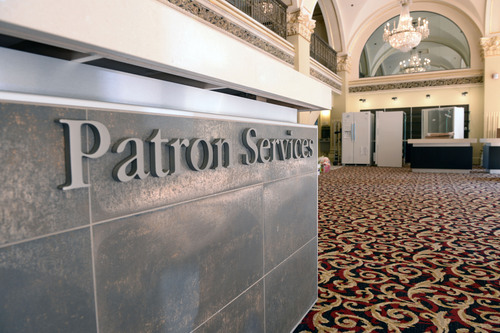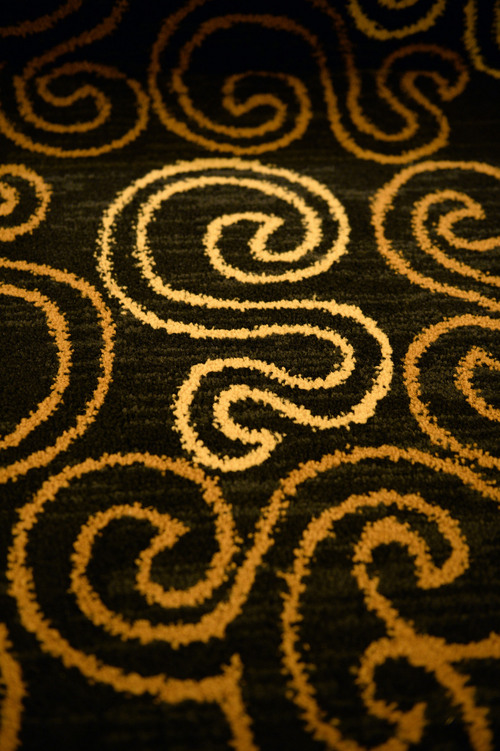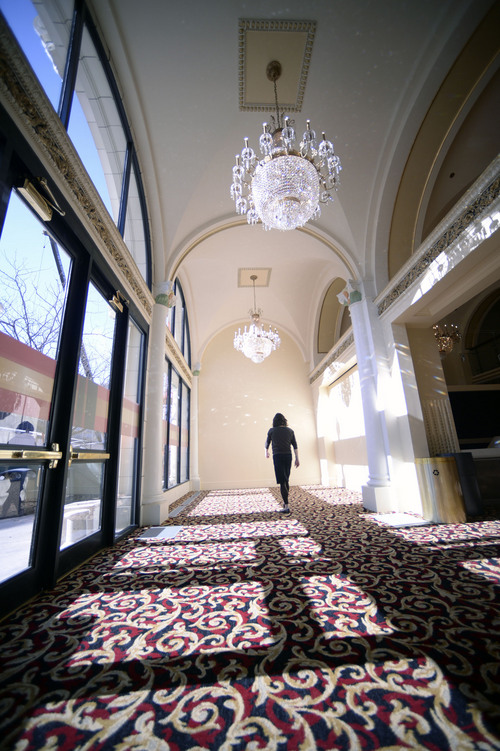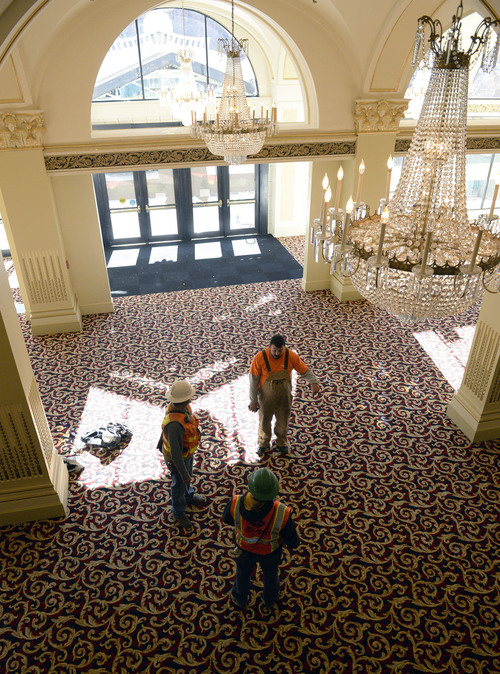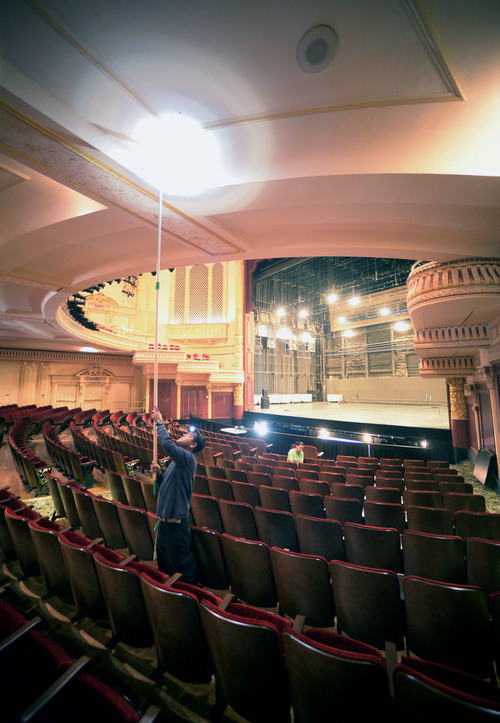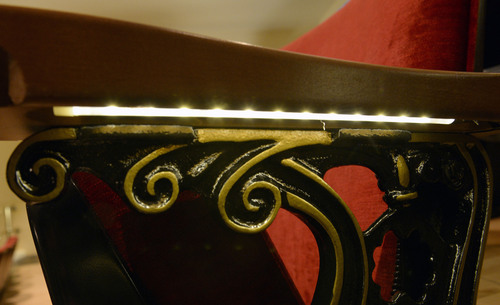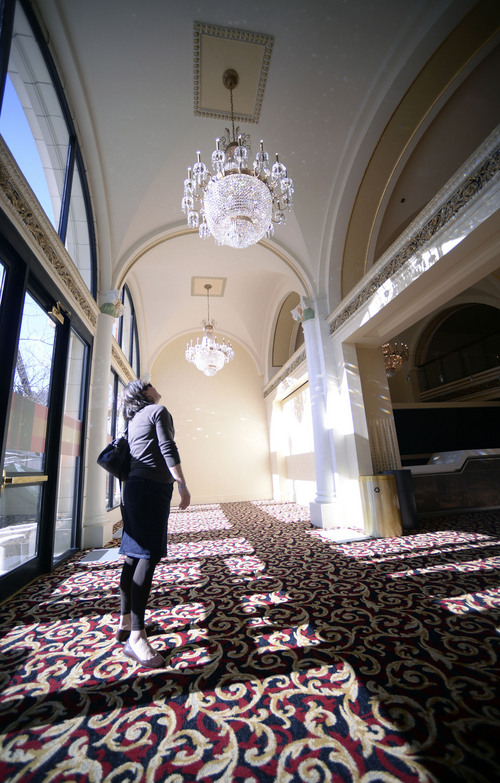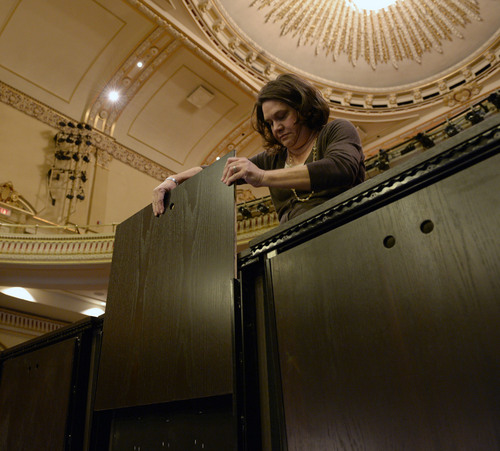This is an archived article that was published on sltrib.com in 2013, and information in the article may be outdated. It is provided only for personal research purposes and may not be reprinted.
After a six-month intermission, a remodeled Capitol Theatre will open this week for its next act.
"She's a grand woman," says Shar Quinney, who only uses female pronouns to refer to the newly renamed Janet Quinney Lawson Capitol Theatre building. "I've been in theaters all over the world, in some of the grandest and beautiful theaters, and she holds up."
The $6 million renovation is the first phase of a $33.4 million project that includes the construction of the adjacent Jesse E. Quinney Ballet Centre, scheduled to open in October 2014. "In the long run, it's kind of a minor remodel in terms of what's going to happen next," says Larry Holder, the theater's head electrician.
Note to theatergoers: Don't expect to appreciate the 30 new bathrooms yet. The intermission traffic jam won't be relieved until the new building opens next year.
What will be unveiled in this act is a design and functionality upgrade to the iconic building's lobby and theater, thanks to new carpeting, 1,900 refurbished seats, and new heating and cooling systems. "Buttoning the building up" is how Roger R. Phillips, of HKS Architects, describes the project.
Theater sightlines have been improved, while an expanded, upgraded orchestra pit is the centerpiece of an "adjustable acoustic" sound remodeling.
The project, designed by HKS Architects and built by Okland Construction, drew upon local knowledge and craftsmanship, while working under fast-track deadlines to open for "Nutcracker" season.
After all, designers and construction crews understood exactly what was at stake.
"It's a civic thing," not just a personal or professional accomplishment, says Brian D. Junge, director of design for the local office of HKS. "We participate in every ballet and opera event."
Okland project executive Troy Thompson says he has two daughters who are dancers and alumni of the children's cast of "Nutcracker."
Adds Michael Currey, Ballet West's production director: "It's going to seem brand new to everybody coming into the theater."
—
New finishes on historic bones • As Ballet West opens its 50th-anniversary run of "The Nutcracker," you'll enter the theater through a newly carpeted, expanded lobby, with reconfigured spaces for the box office and patron services. A temporary concessions area will be in place until the new building opens.
Designers wove contemporary touches into the historic building, and historic influences into the design of the new building, says Emir Tursic, HKS vice president.
In the house, you'll be guided to your seats with new aisle lighting before settling into newly upholstered seats — dressed in Champagne Currant crushed velvet — complete with cushions that have lumbar support.
"Immediately noticeable," says Melinda Cavallaro, associate division director for the county's Center for the Arts.
"The seats are exquisite," adds Shar Quinney, who was head of Ballet West's capital campaign.
As the show begins, dancers will be performing on a stage that was raised 6 inches to offer better sightlines. And you should be able to hear the orchestra better, thanks to a system of "adjustable acoustics" that allows sound to be projected differently for different performances, says consultant C. Russell Todd, of Akustiks a Norwalk, Conn., company.
You probably won't notice how the room is tuned, with new acoustic panels in the orchestra pit, on the pit's railings and under the box seats in the theater, which can be set differently for ballet, opera, or jazz or Broadway shows. For example, the ballet requires more natural sound, with more of the orchestra's sound projected into the audience, while for operas, the sound of the pit musicians has to be balanced so it doesn't overpower the singers onstage.
In addition, groups of musicians, such as the string section, can be positioned at different elevations on pit lifts to help balance the way their sound is projected into the house.
"The main change people will notice in the house is that we've dramatically reduced the mechanical system noise, particularly up in the balcony," Todd says. That's thanks to new heating and cooling systems, which are different for the front and the back of the house — so it will be easier to keep the temperature for dancers near 72 degrees, as required by the performers' union contract. "That's always been a challenge in a 100-year-old theater," Currey says.
—
The fabric of cultural history • For some longtime Capitol Theatre employees, this renovation feels as personal as redoing their own living rooms. The theater is part of the fabric of Salt Lakers' cultural experience, Cavallaro says.
County employees have heard the stories of marriage proposals that took place in the lobby, and listened at "Nutcracker" performances as parents tell their kids about their own memories performing as children in the ballet cast.
Cavallaro and other county employees remember standout shows over the years, as well as the stars, such as Robert Goulet and Carol Channing, who have graced the theater's stage. Cavallaro remembers a concert by Bobby McFerrin in the early 1990s that was particularly memorable for the way he engaged the audience to vocalize with him. "He had them in the palm of his hand," she remembers. "It was very moving for me because it was art at its purest form."
Then there was the time Debbie Reynolds, on tour in 1990 in "The Unsinkable Molly Brown," wandered through the aisles before the show dressed in her character's fur hat and coat to greet ushers who were stuffing programs. And then there was the event of the first touring show of "Les Misérables," when local theater lovers camped out and formed lines around the block to buy tickets.
One of the theater's technical directors, Tom Bryce, remembers the flying rigs for "Peter Pan." More recently, he recalls watching elephants and other characters from "The Lion King" making entrances through the aisles, after getting dressed in the lobby due to the way the oversized show spilled into every available space.
Over the summer, at first the remodel seemed depressing for Bryce, who has worked in the building since the 1970s. When he started at the Capitol, there were still animal cages in the basement, a holdover from the theater's vaudeville days. "They tore everything out that I had worked on," Bryce says of the stage, the orchestra pit, the dressing rooms. "And then they made it look brand new."
While the cages were ripped out long ago, other more contemporary mementos of the building's service as a roadhouse remain. What has largely been left intact are the colorful logos and autographs painted onto the basement's cinderblock walls, recalling more than 50 touring and resident shows that have performed in the building.
facebook.com/ellen.weist Tuning up the Capitol Theatre
Preparing for the opening of the remodeled historic theater required a tuning session in the orchestra pit, according to acoustical consultant C. Russell Todd, of Akustiks.
How the pit will be configured for ballet performances
New orchestra pit rail panels will be set to open — or "transparent" — to allow sound to pass through into the audience.
New adjustable rear wall panels in the pit will be set to "reflective."
Two new orchestra pit lifts will be raised in a stepped configuration to balance the sound of the orchestra.
New panels on the sides of the theater, hidden behind lattice screens below the box seats, will be closed to project sound into the audience.
New acoustical treatments to the overhang of the pit mean that musicians should be able to rehearse without protective sound shields, as previously required.
How the pit will be configured for opera performances
New orchestra pit rail panels will be closed — or "reflective" — to strike a balance between stage performers and musicians.
New adjustable rear wall panels in the pit will be set to "absorptive."
Two new orchestra pit lifts will be raised in a stepped configuration, but positioned at a slightly lower elevation than the ballet setting, to balance sound between the orchestra and singers.
New theater side panels will be opened to balance the sound of singers and orchestra players and to project out into the audience the sound of the singers. "We love the clarity coming out of the pit," says Utah Opera artistic director Christopher McBeth, who attended the tuning session. In addition, musicians say they can hear themselves and their colleagues "1,000 times better." —
About the new Jessie E. Quinney Ballet Centre
Part of what made the Capitol Theatre remodel such an unusual project is its aggressive deadline, required so the theater wouldn't be dark for more than six months. That led to a phased project, so the remodel took place at the same time the adjacent site was prepared for the construction of the Jessie E. Quinney Ballet Centre next door.
That preparation is most visible in the multiple openings cut into the theater's west wall, which was anchored with rebar and shotcrete to make the building more seismically stable.
Those openings will later connect the historic theater with the new building via a glass atrium, which will provide accessibility for wheelchair patrons to all levels of the building. "This simple void sets the buildings apart, but at the same time bridges the gap between them physically and as a simple metaphor," according to HKS Architects' project plan.
The holes are temporarily boarded up but in the future will be fitted with doors that serve as sound and light locks. "The nice thing is patrons won't experience the holes in this phase," says Brian Junge, of HKS Architects.
In addition, the tightly packed downtown site offered its own set of challenges for construction crews, necessitating "just in time" ordering for building materials. "We have to be creative in how we stage cranes and concrete pumps, as there's no room on the site to park cranes or store construction materials," says Troy Thompson, of Okland Construction. In addition, the company plans some work after hours and at night in order not to disrupt nearby businesses. —
Backstage at Salt Lake City's grande dame
Capitol Theatre, at 50 W. 200 South, sits on the site of what was once the Walker Opera House, built in 1882. The theater burned to the ground several years later when a stagehand knocked over a gas lamp and the scenery caught on fire.
The site then housed the Salt Lake Hardware warehouse.
In 1913, the warehouse was remodeled by the national Orpheum Theatre chain into a vaudeville house. The building's history was evident in the animal cages that remained in the basement when Salt Lake County remodeled the theater in the 1970s.
The theater cost $250,000, paid by civic leader M.H. Walker, and was said to be fireproof. It was the first air-conditioned theater in the West, thanks to an innovative ventilating system based on water sprays in the basement, which circulated water upstairs to cool the air in the theater.
The building's façade was designed by prominent San Francisco theater architect G. Albert Lansburgh in an Italian Renaissance style. The façade was notable for its tapestry diagonal brick patterning, as well as terra-cotta detailing, with pink, orange and blue pastel-colored cherubs.
In 1927, the theater was renovated to show talkie movies. The building was renamed the Capitol Theatre in the 1930s, and its lobby hosted various businesses, including a bike shop.
In 1936, the terra-cotta façade was replaced with "modern" metal facings.
After county taxpayers passed an arts bond in 1976 to build Abravanel Hall and purchase and restore Capitol Theatre as a performing-arts center, the original drawings and patterns for the theater's façade were discovered in a San Francisco warehouse.
"It's not a restoration in a best-guess or of-the-time way," said Kerry McCoun, patron services manager for the county's Center for the Arts, who often leads tours of the theater. "Instead, it's a serendipitous happenstance. The building was meant to carry forward as a historic gem in Salt Lake City."
The building's interior and exterior ornamentation, including the massive beehive decorating the ceiling of the house, is largely as it was in 1913, she says. —
Ballet West
The new season of "The Nutcracker" plays at the Capitol Theatre Dec. 6-28, with a "Nutty Nutcracker" performance on Dec. 30. Most shows are at 7 p.m., with 2 p.m. Saturday and Sunday matinees. Visit http://www.balletwest.org/performances/TheNutcracker for showtimes. And visit http://www.sltrib.com/entertainment for more on the holiday tradition of "The Nutcracker."
Tickets • $30-$80, available at 801-355-2787; artix.org.
Utah Opera
The company will present Verdi's "La Traviata" at the Capitol Theatre on Jan. 18, 20, 22 and 24 at 7:30 p.m,, with a 2 p.m. matinee on Jan. 26.
Tickets • $18-$95; at 801-533-6683 or 801-355-2787; arttix.org
Broadway Across America — Utah season
The touring musical "Bring It On" will play at Capitol Theatre Feb. 25-March 2. Tickets on sale Dec. 6.
Tickets • $30 and up; at 801-355-2200; or 801-355-2787; arttix.org.
Showtimes • Magicspace.net
Jazz SLC
"Brazilian Nights — The music of Jobim" plays Jan. 4 at 7:30 p.m. at Capitol Theatre.
Tickets • $25-$35 at 801-355-2787; arttix.org





